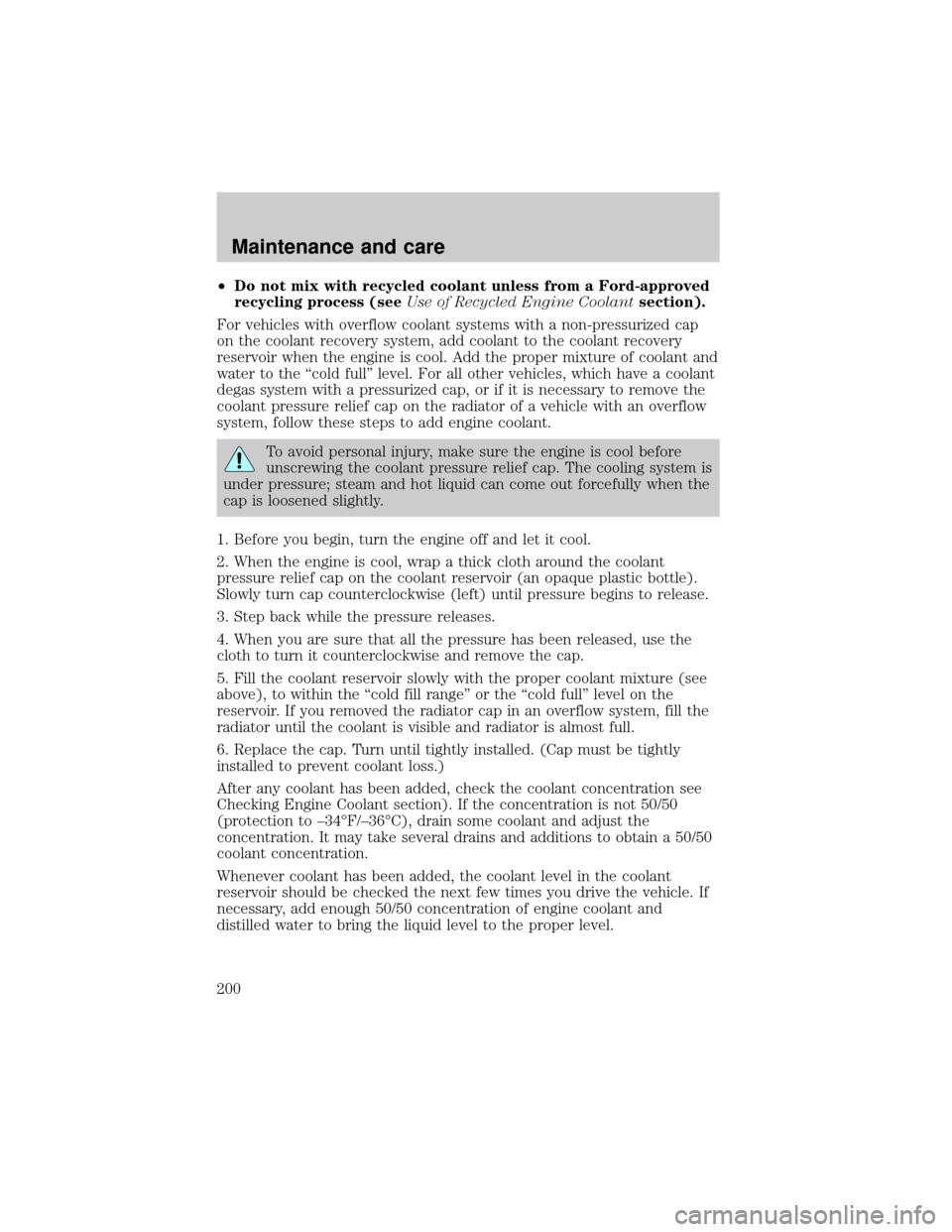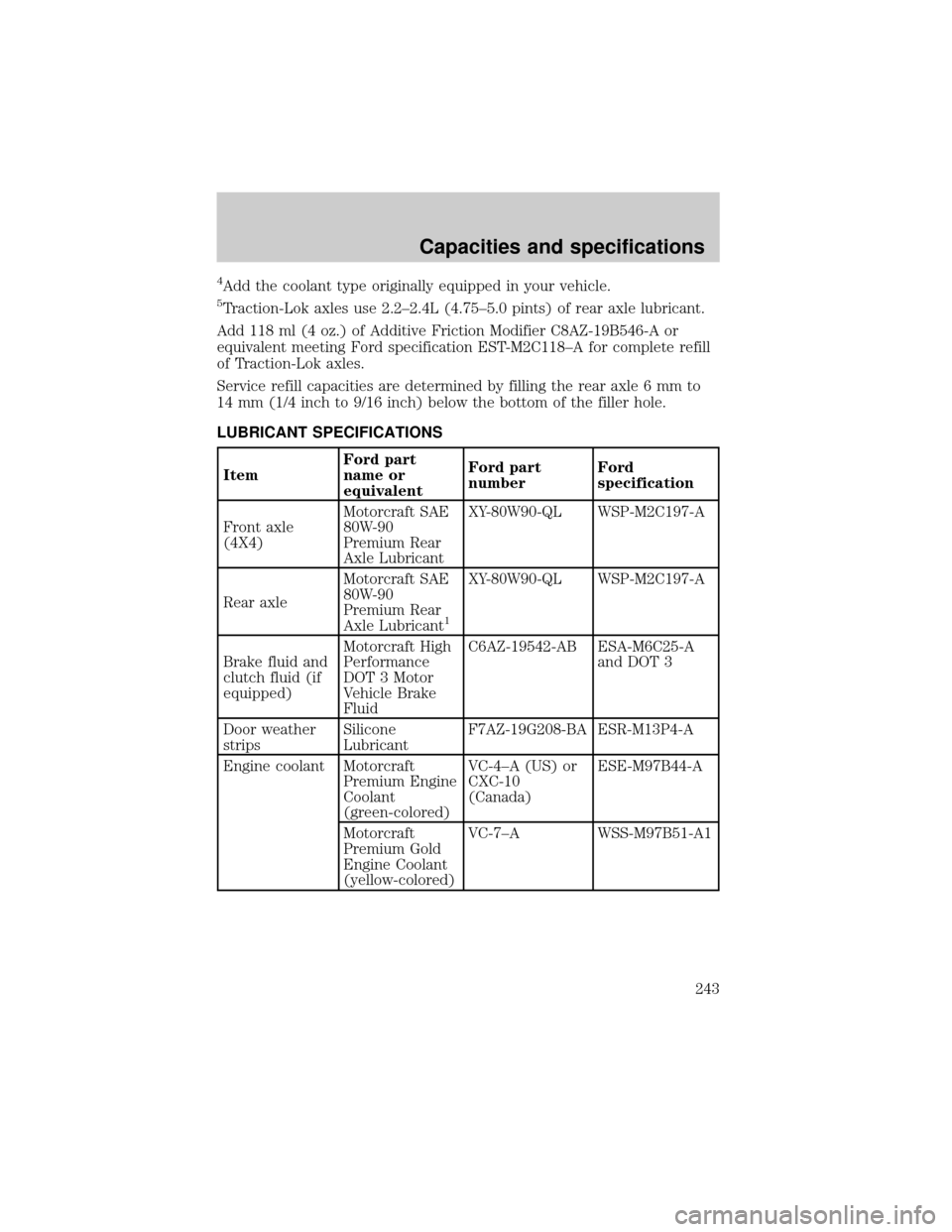engine coolant FORD RANGER 2001 2.G User Guide
[x] Cancel search | Manufacturer: FORD, Model Year: 2001, Model line: RANGER, Model: FORD RANGER 2001 2.GPages: 272, PDF Size: 1.98 MB
Page 200 of 272

²Do not mix with recycled coolant unless from a Ford-approved
recycling process (seeUse of Recycled Engine Coolantsection).
For vehicles with overflow coolant systems with a non-pressurized cap
on the coolant recovery system, add coolant to the coolant recovery
reservoir when the engine is cool. Add the proper mixture of coolant and
water to the ªcold fullº level. For all other vehicles, which have a coolant
degas system with a pressurized cap, or if it is necessary to remove the
coolant pressure relief cap on the radiator of a vehicle with an overflow
system, follow these steps to add engine coolant.
To avoid personal injury, make sure the engine is cool before
unscrewing the coolant pressure relief cap. The cooling system is
under pressure; steam and hot liquid can come out forcefully when the
cap is loosened slightly.
1. Before you begin, turn the engine off and let it cool.
2. When the engine is cool, wrap a thick cloth around the coolant
pressure relief cap on the coolant reservoir (an opaque plastic bottle).
Slowly turn cap counterclockwise (left) until pressure begins to release.
3. Step back while the pressure releases.
4. When you are sure that all the pressure has been released, use the
cloth to turn it counterclockwise and remove the cap.
5. Fill the coolant reservoir slowly with the proper coolant mixture (see
above), to within the ªcold fill rangeº or the ªcold fullº level on the
reservoir. If you removed the radiator cap in an overflow system, fill the
radiator until the coolant is visible and radiator is almost full.
6. Replace the cap. Turn until tightly installed. (Cap must be tightly
installed to prevent coolant loss.)
After any coolant has been added, check the coolant concentration see
Checking Engine Coolant section). If the concentration is not 50/50
(protection to ±34ÉF/±36ÉC), drain some coolant and adjust the
concentration. It may take several drains and additions to obtain a 50/50
coolant concentration.
Whenever coolant has been added, the coolant level in the coolant
reservoir should be checked the next few times you drive the vehicle. If
necessary, add enough 50/50 concentration of engine coolant and
distilled water to bring the liquid level to the proper level.
Maintenance and care
200
Page 201 of 272

If you have to add more than 1.0 liter (1.0 quart) of engine coolant per
month, have your dealer check the engine cooling system. Your cooling
system may have a leak. Operating an engine with a low level of coolant
can result in engine overheating and possible engine damage.
Recycled engine coolant
Ford Motor Company recommends the use of a recycled engine coolant
produced by Ford-approved processes in vehicles originally equipped
with Motorcraft Premium Engine Coolant (green-colored). However, not
all coolant recycling processes produce coolant that meets Ford
specification ESE-M97B44±A. Use of such coolant may harm the engine
and cooling system components.
Ford Motor Company does NOT recommend the use of recycled engine
coolant in vehicles originally equipped with Motorcraft Premium Gold
Engine Coolant since a Ford-approved recycling process is not yet
available.
Used engine coolant should be disposed of in an appropriate
manner. Follow your community's regulations and standards for recycling
and disposing of automotive fluids.
Coolant refill capacity
To find out how much fluid your vehicle's cooling system can hold, refer
toRefill capacitiesin theCapacities and specificationschapter.
Fill your engine coolant reservoir as outlined inAdding engine coolant
in this chapter.
Severe climates
If you drive in extremely cold climates (less than ±36É C [±34É F]):
²It may be necessary to increase the coolant concentration
above 50%.
²NEVER increase the coolant concentration above 60%.
²Increased engine coolant concentrations above 60% will
decrease the overheat protection characteristics of the engine
coolant and may cause engine damage.
²Refer to the chart on the coolant container to ensure the
coolant concentration in your vehicle will provide adequate
freeze protection at the temperatures in which you drive in the
winter months.
Maintenance and care
201
Page 202 of 272

If you drive in extremely hot climates:
²It is still necessary to maintain the coolant concentration
above 40%.
²NEVER decrease the coolant concentration below 40%.
²Decreased engine coolant concentrations below 40% will
decrease the corrosion protection characteristics of the engine
coolant and may cause engine damage.
²Decreased engine coolant concentrations below 40% will
decrease the freeze protection characteristics of the engine
coolant and may cause engine damage.
²Refer to the chart on the coolant container to ensure the
coolant concentration in your vehicle will provide adequate
protection at the temperatures in which you drive.
Vehicles driven year-round in non-extreme climates should use a 50/50
mixture of engine coolant and distilled water for optimum cooling system
and engine protection.
CHECKING AND ADDING POWER STEERING FLUID
Check the power steering fluid.
Refer to the scheduled maintenance
guide for the service interval
schedules. If adding fluid is
necessary, use only MERCONtAT F.
1. Start the engine and let it run until it reaches normal operating
temperature (the engine coolant temperature gauge indicator will be
near the center of the normal area between H and C).
2. While the engine idles, turn the steering wheel left and right several
times.
Maintenance and care
202
Page 241 of 272

Fluid Ford Part
NameApplication Capacity
Power steering
fluidMotorcraft
MERCONtAT FAll Fill to range on
dipstick or
reservoir
Transmission
fluid
1Motorcraft
MERCONtAT F5-speed manual 2.65L (2.8
quarts)3
Motorcraft
MERCONtVATF4x2 vehicles with
automatic and
2.3L I4 engine9.4L (9.9 quarts)2
4x2 vehicles with
automatic and
3.0L or 4.0L
engines9.5L (10.0
quarts)2
4x4 vehicles with
automatic and
3.0L or 4.0L9.8L (10.3
quarts)2
Engine coolant4Motorcraft
Premium Engine
Coolant
(green-colored)
orMotorcraft
Premium Gold
Engine Coolant
(yellow-colored)2.3 L I4 engine
with manual
transmission10.0L (10.5
quarts)
2.3L I4 engine
with automatic
transmission9.7L (10.2
quarts)
3.0L V6 engine
with manual
transmission14.3L (15.1
quarts)
3.0L V6 engine
with automatic
transmission14.0L (14.8
quarts)
4.0L V6 engine
with manual
transmission13.0L (13.7
quarts)
4.0L V6 engine
with automatic
transmission12.5L (13.2
quarts)
Capacities and specifications
241
Page 243 of 272

4Add the coolant type originally equipped in your vehicle.
5Traction-Lok axles use 2.2±2.4L (4.75±5.0 pints) of rear axle lubricant.
Add 118 ml (4 oz.) of Additive Friction Modifier C8AZ-19B546-A or
equivalent meeting Ford specification EST-M2C118±A for complete refill
of Traction-Lok axles.
Service refill capacities are determined by filling the rear axle 6 mm to
14 mm (1/4 inch to 9/16 inch) below the bottom of the filler hole.
LUBRICANT SPECIFICATIONS
ItemFord part
name or
equivalentFord part
numberFord
specification
Front axle
(4X4)Motorcraft SAE
80W-90
Premium Rear
Axle LubricantXY-80W90-QL WSP-M2C197-A
Rear axleMotorcraft SAE
80W-90
Premium Rear
Axle Lubricant
1
XY-80W90-QL WSP-M2C197-A
Brake fluid and
clutch fluid (if
equipped)Motorcraft High
Performance
DOT 3 Motor
Vehicle Brake
FluidC6AZ-19542-AB ESA-M6C25-A
and DOT 3
Door weather
stripsSilicone
LubricantF7AZ-19G208-BA ESR-M13P4-A
Engine coolant Motorcraft
Premium Engine
Coolant
(green-colored)VC-4±A (US) or
CXC-10
(Canada)ESE-M97B44-A
Motorcraft
Premium Gold
Engine Coolant
(yellow-colored)VC-7±A WSS-M97B51-A1
Capacities and specifications
243
Page 263 of 272

A
Air bag supplemental restraint
system ........................................103
and child safety seats ............105
description ..............................103
disposal ....................................107
driver air bag ..........................105
indicator light ...................12, 107
operation .................................105
passenger air bag ...................105
passenger deactivation
switch ................................29, 108
Air cleaner filter .......................240
Air conditioning ..........................22
manual heating and air
conditioning system .................24
Ambulance packages ....................5
Antifreeze (see Engine
coolant) .....................................197
Anti-lock brake system (see
Brakes) ......................................128
Anti-theft system
warning light .............................13
Audio system (see Radio) ...29, 49
Automatic transmission ............132
driving an automatic
overdrive .................................133
fluid, adding ............................203
fluid, checking ........................203
fluid, refill capacities ..............240
fluid, specification ..................245
Auxiliary power point ...........28, 73
Axle
lubricant specifications...243, 245
refill capacities ........................240
traction lok ..............................144B
Battery .......................................207
acid, treating emergencies .....207
charging system
warning light .............................13
jumping a disabled battery ....178
maintenance-free ....................207
replacement, specifications ...240
servicing ..................................207
voltage gauge ............................19
Bed extender ..............................74
Belt minder .................................99
Brakes ........................................128
anti-lock ...................................128
anti-lock brake system (ABS)
warning light .....................13, 129
brake warning light ..................12
fluid, checking and adding ....194
fluid, refill capacities ..............240
fluid, specifications .........243, 245
lubricant specifications ..243, 245
parking ....................................129
shift interlock ..........................132
Break-in period .............................3
C
Capacities for refilling fluids ....240
Cargo area shade ........................74
Cargo net .....................................74
Certification Label ....................248
Child safety restraints ..............113
child safety belts ....................113
Child safety seats ......................114
attaching with tether straps ..118
in front seat ............................115
in rear seat ..............................115
Index
263
Page 264 of 272

Cleaning your vehicle ...............234
engine compartment ..............236
exterior ....................234±235, 239
exterior lamps .........................238
instrument cluster lens ..........238
instrument panel ....................238
interior .....................................239
mirrors .....................................239
plastic parts ............................237
safety belts ..............................239
washing ....................................234
waxing .....................................234
wheels ......................................235
windows ..................................239
wiper blades ............................238
Climate control (see Air
conditioning or Heating) ............22
Clock ..........................32, 39, 48, 62
Clutch
fluid ..........................................195
operation while driving ..........136
recommended shift speeds ....137
Console ........................................73
Coolant
checking and adding ..............197
refill capacities ................201, 240
specifications ..................243, 245
Cruise control (see Speed
control) ........................................65
Customer Assistance ................158
Ford accessories for your
vehicle .....................................256
Ford Extended Service
Plan ..........................................249
Getting assistance outside
the U.S. and Canada ..............255
Getting roadside assistance ...158
Getting the service
you need .................................249Ordering additional owner's
literature .................................260
The Dispute Settlement
Board .......................................252
Utilizing the
Mediation/Arbitration
Program ...................................255
D
Daytime running lamps
(see Lamps) ................................20
Dipstick
automatic transmission
fluid ..........................................203
engine oil .................................189
Doors
door ajar warning .....................14
lubricant specifications ..........243
Driveline universal joint and
slip yoke ....................................207
Driving under special
conditions ..........................142±143
mud ..........................................142
sand .........................................142
snow and ice ...........................143
through water .................142, 144
E
Emergencies, roadside
jump-starting ..........................178
Emission control system ..........225
Engine ................................245±246
check engine/service
engine soon light ......................10
cleaning ...................................236
coolant .....................................197
idle speed control ...................207
Index
264
Page 265 of 272

lubrication specifications ......243,
245
refill capacities ........................240
service points ..................186±188
starting after a collision .........159
Engine block heater .................126
Engine oil ..................................189
checking and adding ..............189
dipstick ....................................189
filter, specifications ........193, 240
recommendations ...................193
refill capacities ........................240
specifications ..................243, 245
Exhaust fumes ..........................127
F
Flexible Fuel Vehicle (FFV) ....215
Fluid capacities .........................240
Foglamps .....................................20
Four-Wheel Drive
vehicles ................................14, 138
control trac ...............................27
description ..............................139
driving off road .......................141
electronic shift ..................27, 139
indicator light .........................139
preparing to drive your
vehicle .....................................131
Fuel ............................................215
calculating fuel economy .......222
cap .....................................11, 218
capacity ...................................240
choosing the right fuel ...........219
comparisons with EPA fuel
economy estimates .................225
detergent in fuel .....................221
filling your vehicle
with fuel ..................215, 218, 222filter, specifications ........221, 240
fuel pump shut-off switch .....159
gauge .........................................16
improving fuel economy ........222
octane rating ...........219, 245±246
quality ......................................220
running out of fuel .................221
safety information relating to
automotive fuels .....................215
Fuses ..................................161±162
G
Gas cap (see Fuel cap) ......11, 218
Gas mileage (see Fuel
economy) ...................................222
Gauges .........................................16
battery voltage gauge ...............19
engine coolant temperature
gauge .........................................17
engine oil pressure gauge ........19
fuel gauge ..................................16
odometer ...................................18
speedometer .............................18
tachometer ................................17
trip odometer ............................18
GAWR (Gross Axle Weight
Rating) .......................................144
calculating ...............................146
definition .................................144
driving with a heavy load ......144
location ....................................144
GVWR (Gross Vehicle Weight
Rating) .......................................144
calculating .......................144, 146
definition .................................144
driving with a heavy load ......144
location ....................................144
Index
265
Page 266 of 272

H
Hazard flashers .........................159
Headlamps ...................................20
aiming ......................................233
bulb specifications ..................232
daytime running lights .............20
flash to pass ..............................21
high beam ...........................13, 21
replacing bulbs .......................227
turning on and off ....................20
warning chime ..........................15
Heating ........................................22
heater only system ...................22
Hood ..........................................185
I
Ignition .........................65, 245±246
Infant seats
(see Safety seats) .....................114
Inspection/maintenance (I/M)
testing ........................................226
Instrument panel
cleaning ...................................238
cluster ................................10, 238
lighting up panel and
interior .......................................21
location of components ............10
J
Jack ............................................171
positioning .......................171, 175
storage .....................171±173, 175
Jump-starting your vehicle ......178K
Keys .......................................85±87
key in ignition chime ...............15
positions of the ignition ...........65
L
Lamps
bulb replacement
specifications chart ................232
cargo lamps ...............................21
daytime running light ...............20
fog lamps ...................................20
headlamps .................................20
headlamps, flash to pass ..........21
instrument panel, dimming .....21
interior lamps ...................71, 233
replacing bulbs .......227, 229±232
Lane change indicator (see
Turn signal) .................................64
Lights, warning and indicator ....10
air bag ........................................12
anti-lock brakes (ABS) ....13, 129
anti-theft ...................................13
brake ..........................................12
charging system ........................13
check coolant ............................12
check engine .............................10
cruise indicator .........................15
door ajar ....................................14
fuel cap light .............................11
high beam .................................13
overdrive off ..............................14
safety belt .................................12
speed control ............................69
turn signal indicator .................13
Load limits .................................144
GAWR ......................................144
GVWR ......................................144
Index
266
Page 271 of 272

Item Information
Required fuel Unleaded fuel only - 87 octane
Fuel tank capacity (Regular
cab-Short wheel base)62.4L (16.5 gallons)
Fuel tank capacity (Regular
cab-Long wheel base)75.7 (20.0 gallons)
Fuel tank capacity (SuperCab) 73.8L (19.5 gallons)
Engine oil capacity (includes filter
change)-2.3L I4 engine3.8L (4.0 quarts). Use Motorcraft
SAE 5W-20 Super Premium Motor
Oil, Ford specification
WSS-M2C153-H.
Engine oil capacity (includes filter
change)- 3.0L V6 engines4.3L (4.5 quarts). Use Motorcraft
SAE 5W-20 Super Premium Motor
Oil, Ford specification
WSS-M2C153-H.
Engine oil capacity (includes filter
change)- 4.0L V6 engine4.7L (5.0 quarts). Use Motorcraft
SAE 5W-30 Super Premium Motor
Oil, Ford specification
WSS-M2C153-G.
Tire size and pressure Refer to the Certification Label on
inside of driver's door.
Hood release Pull handle under the left side of
the instrument panel.
Coolant capacity-2.3L I4 with
manual transmission
110.0L (10.5 quarts)
Coolant capacity-2.3L I4 with
automatic transmission
19.7L (10.2 quarts)
Coolant capacity-3.0L V6 with
manual transmission
114.3L (15.1 quarts)
Coolant capacity-3.0L V6 with
automatic transmission
114.0L (14.8 quarts)
Coolant capacity-4.0L V6 with
manual transmission
113.0L (13.7 quarts)
Coolant capacity-4.0L V6 with
automatic transmission
112.5L (13.2 quarts)
Filling station information
271